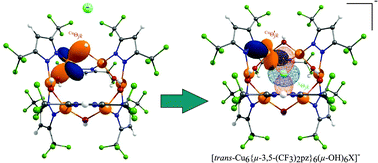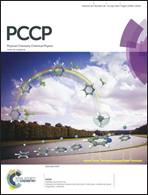A study on the versatility of metallacycles in host–guest chemistry: Interactions in halide-centered hexanuclear copper(ii) pyrazolate complexes†
Abstract
Hexanuclear copper(II) pyrazolate complexes have shown the ability to encapsulate different halide ions, leading to [trans-Cu6{μ-3,5-(CF3)2pz}6(μ-OH)6X]− (X = F, Cl, Br, I). They offer an interesting case study for variation in local properties at host binding sites, due to the presence of a six membered ring involving Cu(II) centers considered as the borderline Lewis acid according to the Pearson Hard and Soft Acids and Bases (HSAB) principle. Here, we describe the host–guest interactions via relativistic density functional calculations, involving the graphical description of local dipole and quadrupole moments, energy decomposition analysis, non-covalent indices, and magnetic behavior. The observed variation in the copper local dipole and quadrupole moments suggests that a metallacycle host offers great advantages in comparison to their organic counterparts, prompted by the versatility of the metallic centers to modulate the surrounding electron density accordingly. According to our results, the contribution of ion–dipole forces in the halide-centered series decreases from 95.0% to 77.0% from the fluoride to the iodide complex, whereas the contribution of higher order interactions such as quadrupole–dipole and quadrupole–quadrupole, goes from 5.0% to 23.0% towards a softer guest. In addition, the through-the-space magnetic response of trans-Cu6{μ-3,5-(CF3)2pz}6(μ-OH)6, reveals a noteworthy aromatic structure, which is driven by the superexchange through the ligands leading to a singlet ground state.


 Please wait while we load your content...
Please wait while we load your content...